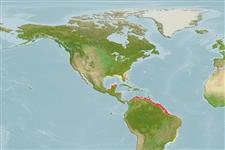Environment: milieu / climate zone / depth range / distribution range
Ecology
Marine; brackish; demersal; depth range ? - 60 m (Ref. 13608). Tropical
Western Atlantic: Tobago to São Paulo, Brazil (Ref. 57756).
Size / Weight / Age
Maturity: Lm ? range ? - ? cm
Max length : 21.3 cm TL male/unsexed; (Ref. 122735); max. published weight: 230.80 g (Ref. 122735)
Dorsal spines (total): 2; Dorsal soft rays (total): 20 - 29; Anal spines: 0; Anal soft rays: 19. All fin membranes brownish proximally, blackish from medial to distally, white extremely; body dark brown; diffuse black saddle-shaped blotches on body, 1 on orbital region and dorsal spine area, 3 on soft dorsal; no black spot except for base of dorsal and opercular spines (Ref. 13608).
Numerous in the estuarine areas of the Brazilian coast; stays motionless in the sandy or muddy bottoms; the venom is injected in the flesh of the victim when pressure is applied on the gland (Ref. 55461).
Life cycle and mating behavior
Maturities | Reproduction | Spawnings | Egg(s) | Fecundities | Larvae
Collette, B.B., 1966. A review of the venomous toadfishes, subfamily Thalassophryninae. Copeia 1966(4):846-864. (Ref. 30721)
IUCN Red List Status (Ref. 130435)
Human uses
Tools
Special reports
Download XML
Internet sources
Estimates based on models
Preferred temperature (Ref.
123201): 25.6 - 28, mean 27.3 °C (based on 264 cells).
Phylogenetic diversity index (Ref.
82804): PD
50 = 0.5156 [Uniqueness, from 0.5 = low to 2.0 = high].
Bayesian length-weight: a=0.00490 (0.00187 - 0.01281), b=3.15 (2.93 - 3.37), in cm total length, based on LWR estimates for this (Sub)family-body shape (Ref.
93245).
Trophic level (Ref.
69278): 3.6 ±0.5 se; based on size and trophs of closest relatives
Resilience (Ref.
120179): Medium, minimum population doubling time 1.4 - 4.4 years (Preliminary K or Fecundity.).
Fishing Vulnerability (Ref.
59153): Low vulnerability (11 of 100).
